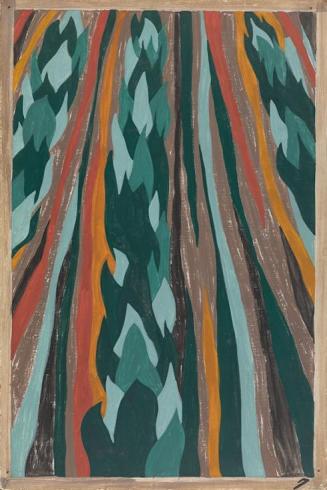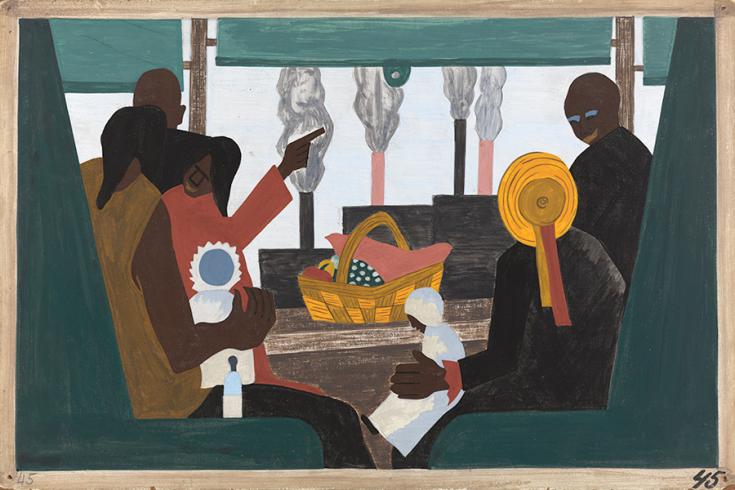Lawrence's Artistic Process - Shapes and Lines

Part 1: Identifying Shapes and Lines
Introduce:
- Watch this short video on Jacob Lawrence’s process for creating The Migration Series.
- Go to The Migration Series site. Click through the panels and stay on each panel for about 10 seconds before moving on to the next. Ask students to write down what they notice about the shapes and the lines.
- What kinds of shapes do you notice in Lawrence’s panels?
- In what circumstances do you notice Lawrence using straight lines?
- In what circumstances do you notice Lawrence using curved lines?
- Explain to students that Jacob Lawrence had a unique process for creating his art. In this lesson, they will learn about how he used shapes and lines.
Discover:
- Lawrence used lots of shapes and lines to show the everyday things he saw — people, buildings, doors, windows, hats, and luggage. Ask students:
- When we looked at the panels, what kinds of shapes did you notice?
- IDENTIFY geometric and biomorphic shapes:
- Show students Panel no. 31. This panel is made up of only geometric shapes.
- Ask students: Based on this panel, how might we describe geometric shapes? What do you notice about the lines?
- Show students Panel no. 9. Point out the cotton and the boll weevil (a type of beetle that eats cotton buds and flowers) as examples of biomorphic shapes.
- Ask students: How might we describe biomorphic shapes? What do you notice about the lines?
- After allowing students to describe geometric and biomorphic on their own, provide them with the definitions of each:
- Geometric shapes are shapes such as triangles, squares, rectangles, circles, trapezoids. We don’t often see them in the natural, outside world. They usually have straight lines and angles.
- Biomorphic shapes are shapes that we see in nature like flowers, animals, and clouds. They usually have curved lines and irregular angles.
- Show students Panel no. 31. This panel is made up of only geometric shapes.
Part 2: A Closer Look
- In partners, study Panel no. 45.
- Students should use this graphic organizer to identify geometric shapes and biomorphic shapes.
- When does Lawrence use geometric shapes?
- When does Lawrence use biomorphic shapes?
Part 3: Artmaking
- After students identify Lawrence’s geometric and biomorphic shapes, they will create their own art using different kinds of shapes.
- Students should select something they see in their neighborhood every day (ex: apartment building, house, cars, buildings, garden, bus stop).
- Using construction paper and crayons or markers, students will create their selected neighborhood scene using geometric and biomorphic shapes. This artmaking project is designed to be open-ended to allow students to express themselves in their own ways. However, if you find your students need more structure, you can provide the following guidance:
- Using construction paper, cut out different biomorphic and geometric shapes.
- Using those shapes, create the neighborhood scene you identified. Make sure to glue down your shapes.
- Only use markers or crayons at the end to fill in any additional details that you need to complete your neighborhood scene.
Share:
- As students present their art pieces, they should:
- Discuss the neighborhood scene they depicted and why they picked it
- Show where they used biomorphic shapes
- Show where they used geometric shapes
Part 4: Optional Extension - Math Connections
Measurement:
- After they’ve created their own pieces, students will measure both the perimeter and area of three geometric shapes included in their art.
- Provide each student with a ruler.
- Review perimeter and area with your students.
- Students should then follow the following steps:
- Select three shapes. The shapes can be the same as long as they’re different sizes, or they can select three different geometric shapes.
- Measure the geometric shapes in order to calculate the perimeter and area.
- Share their work with a partner.
- Teacher Note: If your students have not yet learned multiplication, they can find only the perimeter of the selected shapes instead of both the perimeter and area.
Additional Context
Lesson Context
“I tried to create a staccato-like rhythm over and over and over again [with] the shapes as they move…I build on the geometry and I love it.”–Jacob Lawrence
In 1940, Jacob Lawrence rented his first studio to prepare and lay out the 60 panels that would comprise The Migration Series. He wrote panel captions from his initial research, often with the help of fellow artist and future wife, Gwendolyn Knight. He then developed drawings to accompany each of the 60 captions. Lawrence drew all 60 compositions before beginning to paint. He then painted the series all at once, color by color—starting with black and burnt-umber browns, and moving to cadmium red, orange, and yellow. The limited color palette and Lawrence’s technique of applying colors one at a time across the series enabled him to keep the panels consistent and bring together the work cohesively.
Lawrence created his panels using shapes of even, matte color. To create a strong effect, he put contrasting colors next to each other and used bold patterns to create a more dramatic effect. To make his art feel like it was moving, he used many two-dimensional shapes with strong diagonal lines (like triangles). The light and dark colors next to each other created contrast. This process helped to express a mood and story throughout the panels.
One of his first art teachers, Charles Alston, an African-American painter and educator whose art explored racial identity as well as the personal and common aspects of the Black experience, encouraged Lawrence to see and express the geometric shapes and patterns present in everyday life. Alston encouraged Lawrence to look at parts of his everyday life ranging from the decor of his family’s apartment to the streets of New York.
Key Terms
Biomorphic shapes: Shapes that we see in nature like flowers, animals, and clouds. They usually have curved lines and irregular angles.
Geometric shapes: Shapes such as triangles, squares, rectangles, circles, trapezoids. We don’t often see them in the natural, outside world. They usually have straight lines and angles.




